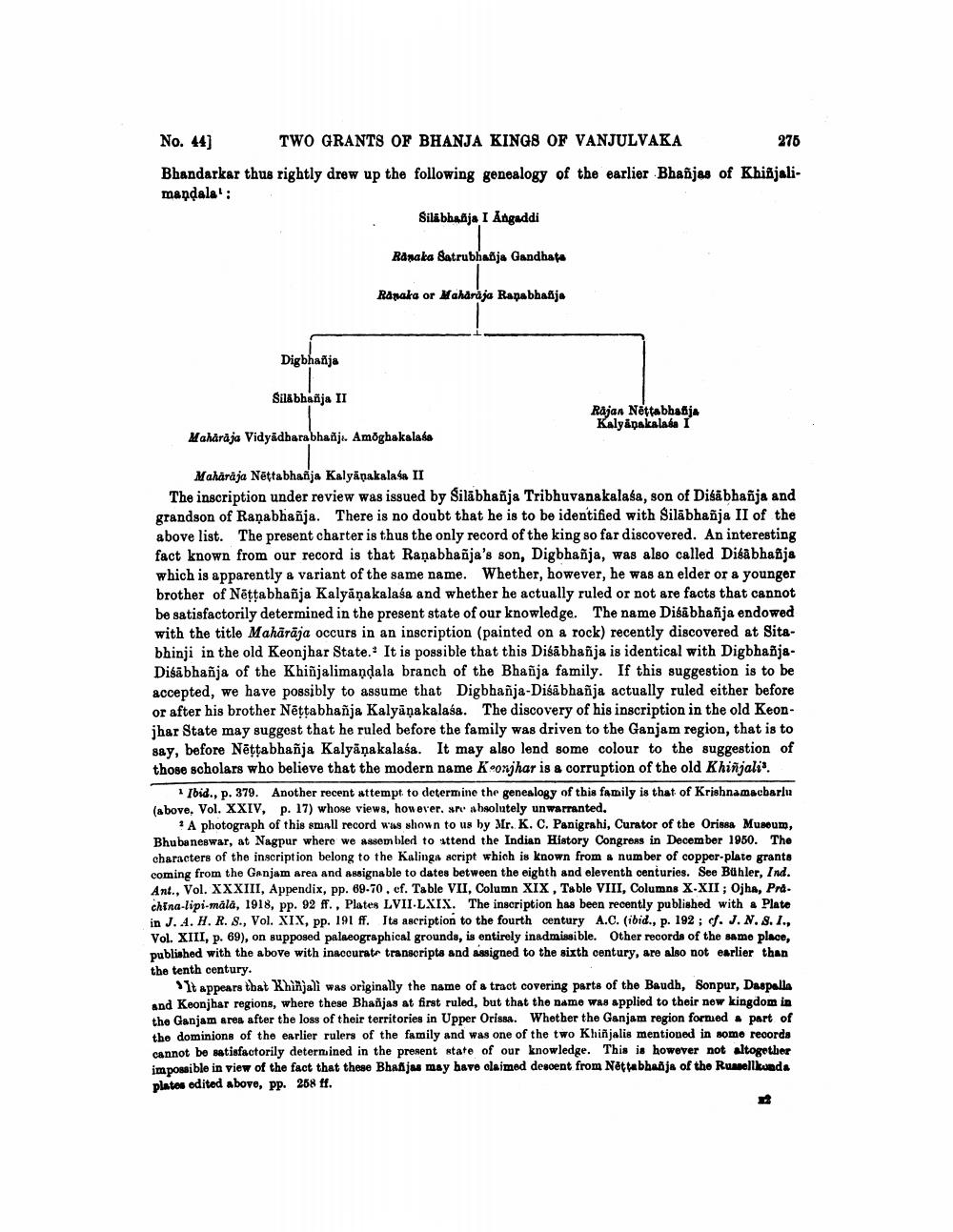________________
No. 44] TWO GRANTS OF BHANJA KINGS OF VANJULVAKA
276 Bhandarkar thus rightly drew up the following genealogy of the earlier Bhaõjas of Khiñjalimandala:
Silabhafija 1 Angaddi
Ramaka Satrubhañja Gandhata
Rapaka or Maharaja Rapabhafije
Digbhaja
Silabhañja II
Rajan Néttabbaõja Kalyánakalasa I
Maharaja Vidyadharabhažje. Amoghakalasa
Mahārāja Néttabharja Kalyāņakalasa II The inscription under review was issued by Silābhañja Tribhuvanakalasa, son of Disābhañja and grandson of Ranabhañja. There is no doubt that he is to be identified with Silābhañja II of the above list. The present charter is thus the only record of the king so far discovered. An interesting fact known from our record is that Ranabhanja's son, Digbhañja, was also called Disabhafija which is apparently a variant of the same name. Whether, however, he was an elder or a younger brother of Nēţtabhañja Kalyāņakalasa and whether he actually ruled or not are facts that cannot be satisfactorily determined in the present state of our knowledge. The name Disabhañja endowed with the title Mahārāja occurs in an inscription (painted on a rock) recently discovered at Sitabhinji in the old Keonjhar State. It is possible that this Disābhañja is identical with DigbhañjaDisābhañja of the Khiñjalimandala branch of the Bhañja family. If this suggestion is to be accepted, we have possibly to assume that Digbhanja-Diśābhañja actually ruled either before or after his brother Nettabhañja Kalyāņakalasa. The discovery of his inscription in the old Keonjhar State may suggest that he ruled before the family was driven to the Ganjam region, that is to say, before Nēțţabhañja Kalyāņakalasa. It may also lend some colour to the suggestion of those scholars who believe that the modern name Keonjhar is a corruption of the old Khinjali'.
Ibid., p. 379. Another recent attempt to determine the genealogy of this family is that of Krishnamacbarlu (above. Vol. XXIV, p. 17) whose views, however, are absolutely unwarranted.
! A photograph of this small record was shown to us by Mr. K. C. Panigrahi, Curator of the Orissa Museum, Bhubaneswar, at Nagpur where we assom bled to attend the Indian History Congress in December 1950. The characters of the inscription belong to the Kalinga script which is known from a number of copper-plate grants coming from the Ganjam area and assignable to dates between the eighth and eleventh centuries. See Bühler, Ind. Ant., Vol. XXXIII, Appendix, pp. 69.70. cf. Table VII, Column XIX , Tablo VIII, Columns X-XII; Ojha, Prd. china-lipi-mala, 1918, pp. 92 ff., Plates LVII.LXIX. The inscription has been recently published with a Plate in J. 4. H. R. S., Vol. XIX, pp. 191 ff. Its ascription to the fourth century A.C. (ibid., p. 192; cf. J. N. 8. I., Vol. XIII, p. 69), on supposed palaeographical grounds, is entirely inadmissible. Other records of the same place, published with the above with inaccuratr transcripts and assigned to the sixth century, are also not earlier than the tenth century.
'It appears that Khiñjali was originally the name of a tract covering parts of the Baudh, Sonpur, Daspalla and Keonjhar regions, where these Bhañjas at first ruled, but that the name was applied to their new kingdom in the Ganjam area after the loss of their territories in Upper Orissa. Whether the Ganjam region fornedpart of the dominions of the earlier rulers of the family and was one of the two Khiñjalis mentioned in some records cannot be satisfactorily determined in the present state of our knowledge. This is however not altogether impossible in view of the fact that these Bhajas may have claimed descent from Nattabhaja of the Ruanellkuads platos odited above, pp. 258 ff.




